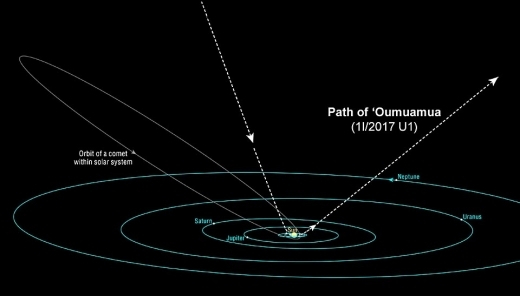
The bait was offered and various sections of the media rapidly pounced on Oumuamua and devoured it with relish. We are awash with stories such as this …
.. and also the slightly more factually correct variations …
- Sky News: Cigar-shaped object could be alien spacecraft, Harvard researchers claim
- NBC: Scientists Say Mysterious ‘Oumuamua’ Object Could Be an Alien Spacecraft
So what was actually claimed?
Let’s take a look at the the alpha source for it all.
Could Solar Radiation Pressure Explain ‘Oumuamua’s Peculiar Acceleration?
The paper written by Shmuel Bialy and Abraham Loeb of the Harvard Smithsonian Center for Astrophysics on 30th Oct is specifically focused on exploring one possible explanation for an observation.
First a bit of background.
The Observation
In October of 2017 the Pan-STARRS survey (Panoramic Survey Telescope and Rapid Response System) in Hawaii found an object that was on a hyperbolic trajectory. Translation: it was coming into our solar system from outside. This was the very first ever observation of an interstellar object passing through our solar system, hence all the interest.
It had an odd shape – an aspect of about 5:1 and was tumbling. This was not directly observed, but was instead calculated by looking at the object’s lightcurve. Any images you have seen are an artists impression.
The 2018 observation (as can be seen from the diagram at the top of this posting) is that it curved around the sun and the exited the solar system. As it left, it was observed to have accelerated. The most immediate thought is that it was perhaps a slingshot effect … but no, this acceleration was a non-gravitational acceleration.
Here is the June 2018 paper that established that it had a non-gravitational acceleration …
Non-gravitational acceleration in the trajectory of 1I/2017 U1 (‘Oumuamua)
The Question
The latest paper is an examination of one question. The hint is perhaps the title of the paper itself …
In other words, could the observed acceleration of the object be explained as momentum imparted by photons from the Sun?
Such an acceleration is naturally expected for comets, driven by the evaporating material. However, recent observational and theoretical studies imply that ‘Oumuamua is not an active comet. We explore the possibility that the excess acceleration results from Solar radiation pressure.
By crunching the numbers they make two discoveries.
- It would have to be very thin …
The required mass-to-area ratio is m/A≈0.1 g cm−2. For a thin sheet, this requires a width of w≈0.3−0.9 mm.
- If it was that thin it could still be interstellar
We find that although extremely thin, such an object would survive an interstellar travel over Galactic distances of ∼5 kpc , withstanding collisions with gas and dust-grains as well as stresses from rotation and tidal forces.
Speculation
OK, so if that is the explanation, then what is it?
They speculated as a bit of a tease at the end that perhaps that it might be an artificial lightsail.
Key Point: Most of the paper consists of maths calculations focused on the question. Just the last two paragraphs drop in the speculation as a bit of a speculative punt – not a scientific fact.
We don’t know if solar radiation is the actual explanation. All this paper does is to establish that if that is correct, then the object must be very thin.
We don’t know if it is actually thin, or for that matter, we don’t really know what its actual shape was, we just know that it had a 5:1 aspect.
In other words, the entire scientific foundation for it being an “alien spacecraft” is … well yes, nothing at all.
So what caused it?
The earlier June 2018 paper did offer this explanation …
we find comet-like outgassing to be a physically viable explanation, provided that ‘Oumuamua has thermal properties similar to comets.
Why would this latest paper even speculate about Aliens?
It is click-bait media fodder, so the response could have been anticipated. The enthusiasm for such thinking is perhaps coming from one of the authors, Avi Loeb. He did recently write an essay in Scientific American on the topic about a month ago, so clearly it is stuff he does speculate about …
How to Search for Dead Cosmic Civilizations
If they’re short-lived, we might be able to detect the relics and artifacts they left behind
He is also Chair of the Advisory Committee for the Breakthrough Starshot project – which aims to launch lightweight spacecraft towards the nearest stars, so speculating that others out there might be doing something similar is very much on his mind.
The bottom line is this; The authors don’t actually seriously believe it is an alien spacecraft, and neither should you.
Finally, there is also this …
It is worth reading the thread that comes with this tweet …
The thing you have to understand is: scientists are perfectly happy to publish an outlandish idea if it has even the tiniest *sliver* of a chance of not being wrong. But until every other possibility has been exhausted dozen times over, even the authors probably don’t believe it.
— Katie Mack (@AstroKatie) November 6, 2018